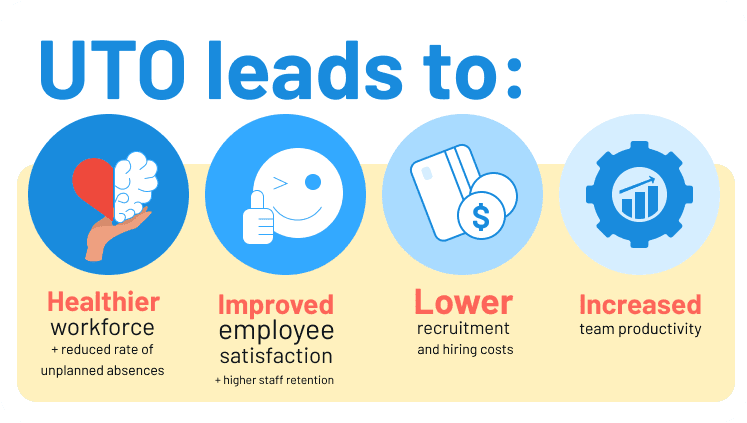Time off is an intrinsic part of every employee’s professional life. When managed well, it can produce plenty of benefits for both the employers and their teams.
Companies handle their staff members’ leave time differently, depending on the legal environment where they operate, their workplace culture and corporate values. But in general, leave benefits across businesses are a combination of paid and unpaid time off.
In this piece, we will discuss every aspect of unpaid time off management from the employers’ perspective. Here, you will learn what unpaid time off is and how to create an efficient time off policy. You will also read about some relevant laws, the benefits of unpaid time off and the best leave management practices.
What is Unpaid Time Off?
Unpaid time off is leave time that is not compensated by the employer. Usually, it is taken for a short period of time for reasons like jury duties, volunteer work, funeral, medical appointment, relocation and more.
Most of the companies don’t let their staff members make use of unpaid time off that freely and prefer to apply specific rules on how and when a person can request unpaid time off:
- It’s not uncommon for employers to limit the number of paid and unpaid days off a worker is allowed to take a year to avoid problems with workload distribution.
- An employer may reject an unpaid time off request and ask a worker to postpone their vacation in case the company experiences staff shortages and similar problems.
- Provided that a paid time off (PTO) policy is adopted in a firm, an employee is likely to be required to deplete their PTO balance before taking some unpaid days off.
The latter rule implies that some companies offer unpaid time off in addition to PTO. But many organizations provide it instead of PTO, which is particularly frequent in such countries as the United States, where employers have no legal obligations to pay for their workers’ vacation.
PTO vs. Unpaid Time Off
Basically, there are two major types of employee leave – paid and unpaid. Both of them can be taken to indulge in a short break from work, recover from a disease and attend to some personal needs or the needs of the loved ones. The main difference between the two is that unpaid time off is not compensated by an employer – an employee has to pay for it from their own pocket.
Let’s take a look at some legal issues related to unpaid time off.
Relevant Labor Laws
In the United States, employers are generally left to decide whether to offer paid or unpaid time off to their employees since there are no federal laws mandating to give any sort of vacation time to workers. However, under the Family and Medical Leave Act (FMLA), companies with over fifty staff members are required to provide up to twelve weeks of unpaid leave time a year in case an employee needs to:
- Recover from a serious health condition,
- Take care of an ill / sick family member,
- Give birth to a child or take care of a newborn baby, etc.
Besides, employers have no right to fire or discipline an employee who wants to take a break from work in order to perform jury service. It means that a person must be able to procure enough unpaid leave time (or PTO) for that specific occasion.
State laws are worth employers’ close attention too:
- Thirteen states and Washington D.C. have recently enacted the paid sick leave regulations requiring private-sector employers to pay for workers’ sick days.
- Some states, such as Florida and Illinois, have domestic violence leave laws that enable employed individuals to take some time off due to reasons linked to domestic violence without a risk of being fired or disciplined.
- Besides, a large number of states, including California and Maine, regard accrued vacation time as wages.
Still, companies across the United States are generally not required to give either paid or unpaid vacation to their workers.
Main Benefits of Providing Unpaid Time Off to Employees
A decent unpaid vacation policy produces plenty of advantages for an employer, regardless of whether they grant unpaid leave allowances in addition to PTO or not:

By affording more opportunities for team members to have a break from work and focus on personal matters, an employer helps them to better cope with job-related stress, improve work-life balance and enhance their health condition. These effects, in turn, are bound to promote organizational productivity and reduce business costs.
What to Cover in an Unpaid Time Off Policy?
If you want to offer an unpaid leave package to your team members, you need to develop a policy that outlines all the rules and procedures you plan to apply. This document will protect the company from productivity drops, as well as the immense costs of uncontrolled employee absenteeism and time off abuse.
Here are four primary points your policy must specify:
- Is there also a PTO package in your company? If so, you should create a separate PTO policy. Plus, you need to clarify if your workers have to use up their accrued PTO prior to requesting unpaid days off. Note that on some occasions it’s appropriate to let your team members take unpaid leave time even with an unused PTO balance. Disability leave, parental leave, leave due to domestic violence and bereavement leave are just a few examples.
- Which workers have access to unpaid leave time? Full-time, part-time, hourly and salaried employees may all be given unpaid leave time. But since job responsibilities and pertinent payroll processes often vary from one employee group to another, you can establish different time off rules for them.
- How many unpaid days off an employee may enjoy? Unlimited vacation is a growing trend, yet many employers would feel uncomfortable with such a flexible approach to time off management. You need to decide if you want to limit the amount of unpaid time off a worker can take a month / year. Additionally, you should specify if any particular time off accrual rules are to be applied (e.g., two days off will be added to a worker’s balance each month) and if a person can have an unlimited leave period due to some reasons (e.g., serious illness).
- What is your leave request process? Make sure to inform your employees how far in advance they must send requests to you and which tools they need to apply for this purpose. You also must indicate what happens if more than one person wants to take a vacation for the same period – will you approve leave requests in accordance with the “first come, first served” principle or consider some other things too (e.g., the total volume of hours worked and tasks accomplished after the last vacation, etc.)?
Unpaid Time Off Policy Sample
To minimize absenteeism and time off abuse, your company should have detailed and clear guidelines regulating unpaid time off. If you don’t have an unpaid time off policy in your company yet, the following unpaid time off policy sample will become your time-saver when developing one.
A well-rounded unpaid time off policy should specify the following:
- Cases when employees can ask for an unpaid leave
- The number of unpaid days employees can take
- How far in advance should employees request unpaid time off
- The procedure of unpaid time off request
- How often employees can request unpaid time off
- Cases when unpaid time off requests won’t be granted
- Is there any cap for unpaid time off from work
Key Rules of Successful Unpaid Leave Management
Leave request processing, time off accrual, absence tracking and data analysis are the four core components of successful leave management. For better results, do the following:
- Use a straightforward calendar for scheduling and absence tracking. Digital calendars are a better option – they allow users to add, edit and review necessary data easily and, thus, save a ton of time.
- Make the process of leave request creation as trouble-free as possible. Consider using a piece of software that will enable your staff members to freely see how many hours are left in their unpaid or paid leave balances, make leave requests in just a few clicks and access important information on the go.

- Automate time off accrual and request approval. Manual calculations are painstaking. Also, looking through minor leave requests often takes much time and adds to the workload significantly. By streamlining these tasks with a software app, you will increase efficiency and save a lot of valuable resources.
- Analyze time off data to predict workforce capacity, prevent absenteeism and improve time off management. A quality absence management app will assist you in collecting those data systematically and will quickly process them for a deeper insight into employee trends.
If you’re looking for a smart time off management system that incorporates many valuable features, consider actiPLANS. This tool streamlines time off accrual, leave planning and request approval. Besides, it fosters an easy overview of available resources and an intelligent analysis of the company’s leave time statistics.
Sign up for a free 30-day trial today and improve your unpaid time off management experience with actiPLANS.















